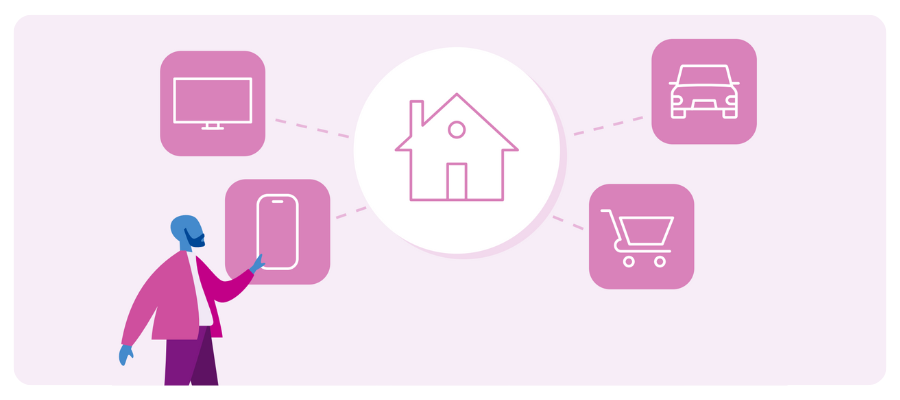
Originally appeared in The Current
Forget the cookie delay — AI is already rewriting the rules of advertising.
While the industry was busy debating yet another postponement of Chrome’s third-party cookie phaseout, AI quietly became the most disruptive force in marketing. But here’s the twist: AI doesn’t work without identity. If marketers want results — real outcomes, not just impressions — they need to prioritize the data that makes AI go.
First-party data strategies are now mainstream. Interoperable identity solutions like Unified I.D. 2.0 (UID2) and ID5 are gaining adoption across the open web. Connected TV (CTV) has grown into a performance-focused, cookieless channel. Contextual and geo-based targeting have become smarter and more scalable. Identity graphs are helping marketers stitch together signals across devices, platforms, and channels.
The foundation for a better ecosystem isn’t being built — it’s already here.
The AI hype is over — and the stakes are higher
It’s no longer buzz. AI is here, and it’s already reshaping how we plan, activate, and measure advertising.
We’re seeing the rise of agentic AI: systems that don’t just surface insights but act on them. These AI agents are identifying patterns, building audiences, optimizing media buys, and analyzing performance. AI is helping marketers stop guessing and start improving.
But there’s a catch — one we can’t afford to overlook.

AI is only as good as the data it works with. “Garbage in, garbage out.” as the saying goes. And in advertising, that means if you don’t know who you’re reaching, even the smartest AI won’t drive results. To unlock AI’s full potential, marketers need a strong, privacy-safe identity foundation.
Identity is the fuel that makes AI work
AI can personalize creative, optimize in-flight campaigns, and even recommend which channels to prioritize — but it can’t do any of that well without context. And context starts with identity.

Identity connects signals from different devices, logins, channels, and interactions to real people. It tells your AI models who you’re talking to — not just what they clicked. That kind of clarity gives AI the power to make smarter predictions, uncover insights, and deliver relevance at scale. Without identity, AI is guessing. With identity, it’s delivering.
Identity is the foundation of the outcomes era
We’re living in a performance-driven age. Impressions and clicks are no longer enough. Marketers today are being judged by real outcomes: incremental sales, customer acquisition, revenue lift, and long-term value.

To measure those outcomes, you need to know who you reached — and whether they took action. Identity makes that connection possible. It links ad exposure to real-world results. It enables accurate attribution across channels. It powers personalization at every stage of the journey, making every impression more valuable.
This is the outcomes era, and identity is what makes it measurable.
Commerce media and CTV show what’s possible
Two of the fastest-growing channels — commerce media and CTV — are great examples of identity in action.
At Experian, we’ve invested in this future. Our recent acquisition of Audigent brings together data, identity, and activation — under one roof — built to support both AI-driven planning and outcome-based performance.
How marketers can win now
To stay ahead in a world defined by AI and outcomes, marketers need to:
It’s not about rebuilding everything. It’s about building on what’s already working.
Final thought: Identity is the bridge
AI is raising the bar, and outcomes are the new standard. But neither works without identity. The marketers who win won’t treat identity as a compliance checkbox — they’ll treat it as their competitive edge.
Get started with us today
Latest posts

It seems that every time I go into a store today, I am offered a loyalty card. From one of my favorite local restaurants to my shoe store VIP program, I feel like I am getting a host of emails and points at every turn. Statistics support my theory: according to a recent Experian Data Quality study, 91 percent of organizations use loyalty programs. Why did they become so prevalent? Today’s consumer is more empowered than ever before and driving major change within business. In the era of Yelp, digital channels and a 24/7 shopping cycle, organizations have less control. Just look at the shoe market, which you can tell I pay attention to. It used to be that you would purchase whatever your local department store or brick-and-mortar retail had to offer, which might be 50 different options. Now, you can go online, read reviews and browse hundreds of different choices based on style and color. In fact, last night I went online and searched for black boots and scrolled through six pages of different options! Loyalty programs are a counter balance to that choice and empowered customer behavior. They make sure that while I am shopping for shoes, I am probably doing it through my preferred store and earning reward points for free merchandise. And through the loyalty process, companies are collecting a lot of data. Customers usually need to provide more than three types of information to sign up, the most popular being email, followed by name and phone number. However, collecting this information accurately isn’t always easy, which is why poor data collection is one of the leading problems for loyalty programs. Eighty-one percent of companies face challenges related to these programs, the two biggest being not enough customers signing up and poor contact data. Inaccurate data means that a customer has signed up, but the marketer is unable to communicate with them in the desired channels. This clear drop in communication and a potentially bad customer experience could be by improved data collection. Sixty-four percent of respondents say this is a needed improvement. Let’s go back to my shoe retailer example. If they had collected my email wrong, I wouldn’t get my email confirmations or offers around upcoming sales. If they got my address wrong, I wouldn’t be receiving my shoes. Considering how much money I spend on shoes annually, which I am ashamed to admit, if any of those items went wrong, I might switch to a competitor. That can equate to a lot of money annually, especially when you look at it across a large number of clients. When a customer chooses to sign up for a loyalty program, they are making a commitment to the company and expecting something in return, be it points, free shipping, coupons or just company updates. However, if bad contact information is collected, then the consumer often never receives the benefits, resulting in a bad customer experience. In the next year, marketers need to data validation in place to ensure information is accurate upon collection. This type of software can be implemented across all channels where information is collected and ensure data is accurate while the consumer is still engaged. If information is accurate when it is collected, then loyalty programs have a better chance at engaging consumers and actually seeing the benefit that a loyalty program can provide. To learn more about loyalty programs and the research mentioned above, please read our new white paper, Driving customer loyalty. Contact us today

Black Friday online traffic increased 7% in 2012 versus 2011 as the top 500 retail sites received more than 193.8 million total US visits. So far this Holiday week of online traffic to the top retail sites is up 10% on average. Online retail traffic was up 1% on Black Friday compared to Thanksgiving Day 2012 traffic this year. Amazon.com remained the top visited retail site on Black Friday while Walmart was the second most visited retail site. BestBuy moved up to the 3rd most visited site while Target was the 4th most visited site. JC Penney moved up from being the 8th most visited retail site on Thanksgiving Day to the 5th most visited on Black Friday. Among the top 5 sites, JC Penney saw the biggest day-over-day growth at 26%. Looking at the top 20 retail sites on Black Friday, the Apple Store site saw the biggest day-over-day growth at 99%. Check back for CyberMonday insight and a weekly recap of this week. Contact us today

It is time for us to polish off our crystal ball and give our predictions straight from consumers’ fingertips for the hot products of the 2012 holiday season. Gadgets will reign across many ages Tablets including LeapPads, Tabeos, iPads, Kindles and others will continue to be a popular gift this year, with more choices than ever. On the list of top product-related search terms driving traffic to the Retail 500 category of sites, Kindle Fire HD and Windows 8 top the list as new products. Additionally, Meep!, a child friendly tablet appeared in the top fifteen. Accessories for both phones and tablets will also be popular, especially as the variety grows for iPhone 5 and iPad Mini. A reoccurring favorite gift for the holidays is UGGs which shows a decrease year over year. However, another brand with a similar product is Bearpaw, which is in the top ten searches and has seen big growth year over year.Source: Experian Hitwise Dolls, video games and Furbys, oh my! To identify the popular toys for gifts this year, we researched product-related search terms driving traffic to ToysRUs.com compared to last year’s holiday season. We uncovered trends in the doll category, Doc McStuffins as number one on the list, along with the classic Barbie, which saw a growth in searches year over year. The Furby is making a strong comeback at the number two spot with a reboot and new features. Another trend here is tablets, from branded searches like LeapPad and Kurio there is also the generic term ‘tablets for kids’. In the video game category, the new Wii U that is debuting just in time for Black Friday and should be a big gift this year, along with searches for PS3 games and the Nintendo 3ds xl are all in the top 20 searches.Source: Experian Hitwise Keywords of the consumer to identify demand Beyond product names, it is important to understand the actual way people search, using key phrases and questions. Last year, for example, there was a lot of activity around ‘in-stock’ products, such as the LeapPad explorer, which was hugely popular and quickly sold out in many stores. Retailers and marketers should monitor this throughout the season and make sure to optimize for in stock if there is a popular product that they have available.Source: Experian Hitwise Consumers also focus on what is the ‘best’ – so we see search activity around ‘best place to buy’, particularly around electronics. Questions such as ‘where to buy a’ specific product are also common, such as ‘where to buy a kindle’. These phrases offer opportunities to boost search campaigns by considering how consumers phrase their questions to ensure to capture these searches.Source: Experian Hitwise Quick tip: In the retail category there will tend to be a lot of retail branded store terms but to keep up with holiday search behavior and help make analysis quick, create portfolios of branded terms to easily exclude those from a certain category. When you strip out all the variations of that term you are able to gain insight into product searches that are most popular to a certain site or category. For more insight on the hot product trends for this year from our Hitwise trend-spotters, watch our webcast. Contact us today





